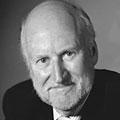NEA Chairman Rocco Landesman speaking at Film Forward Arizona.
Nate von Zumwalt, Editorial Coordinator
The Chairman of the National Endowment for the Arts, Rocco Landesman, was in Arizona last week as part of his Art Works tour. During the visit, he made a stop in Tucson to participate in the week-long Film Forward program and take in a screening of Andrew Okpeaha MacLean’s On the Ice. Landesman was appointed Chairman of the NEA in 2009 and is responsible for leading the public agency in its efforts “to support artistic excellence, creativity, and innovation for the benefit of individuals and communities.” A longtime Broadway theatre producer and consummate arts advocate, he recently shared his thoughts on his firsthand experience with Film Forward, its far-reaching influence, and endless potential for edification through art.
What were your impressions of the Film Forward program and its impact on the Tucson community?
It’s a great program, and I’ve been interacting with it for several years now. It has great international reach without a doubt. The two films that I have seen as part of this program are Winter’s Bone, last year, and On the Ice this year. They’re not only powerful films and very well made films, but they are unbelievably local. They are tied very powerfully to a particular place. You can see, taste, and hear rural Missouri in Winter’s Bone, and those images still resonate with me. And the same thing for Barrow, Alaska, which I encountered last week through On the Ice. Those were very powerful films both in terms of the human relationships you see and also the sense of place.
You’re discovering a place that you don’t know and are engaging for the first time. And to see young filmmakers working at this level, Andrew Okpeaha MacLean—who is a native of Alaska—to see him do a film of this kind of effect is thrilling. The promotion and extension of these movies that Film Forward provides is invaluable. I think it’s fantastic that they help get these movies out there and seen. And our partnership with Sundance Institute, The President’s Committee on the Arts and the Humanities, the National Endowment for the Humanities, and the Institute of Museum and Library Services, is one where we collectively engage film, and it’s an important part of our portfolio and I’m very proud to be a part of it.
How did you feel the audience responded to the screening and the opportunity to interact with the filmmakers?
Everyone who was there was blown away by the film. They had lots of questions about how MacLean casted (there were a lot of non-professionals in the film), how he planned to distribute it (that’s always a huge challenge for films like this when you don’t have a star), and there were lots of questions about that particular place. We all asked about it. I’ve been to Barrow.
It’s one of the grimmest places you can find—I’ll be blunt—but Andrew managed to find a deep humanity there. He presented all of the issues and problems, generational conflicts, the difficulties and challenges of living there, but within that he found a very deep humanity and poetry. And that’s something to be able to do that. Obviously he has a love of his culture. I think the audience was very engaged with that, and that was the subject of much of the discussion.
It’s valuable for these communities with limited access to the arts to have this opportunity, but then again, it’s transitory. What are the larger implications resulting from programs such as Film Forward?
I think it brings some visibility to the community. Part of what artists do when they do something like this is immediately form an identity, form a sense of what that community is. I think it’s very valuable for art to be shown everywhere, in other cultures and other communities. Isn’t that, after all, the most effective kind of diplomacy? To get a real sense of what life is like in a different place, not only life but the culture. The real ethos of a place.




